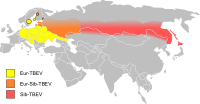
Photo from wikipedia
Tick-borne encephalitis virus (TBEV) and West Nile virus (WNV) are important arthropod-borne zoonotic flaviviruses. Due to the emergence of WNV in TBEV-endemic regions co-circulation of both viruses is increasing. Flaviviruses… Click to show full abstract
Tick-borne encephalitis virus (TBEV) and West Nile virus (WNV) are important arthropod-borne zoonotic flaviviruses. Due to the emergence of WNV in TBEV-endemic regions co-circulation of both viruses is increasing. Flaviviruses are structurally highly similar, which leads to cross-reacting antibodies upon infection. Currently available serological assays for TBEV and WNV infections are therefore compromised by false-positive results, especially in IgG measurements. In order to discriminate both infections novel diagnostic methods are needed. We describe an ELISA to measure IgG antibodies specific for TBEV and WNV, applicable to human and horse sera. Mutant envelope proteins were generated, that lack conserved parts of the fusion loop domain, a predominant target for cross-reacting antibodies. These were incubated with equine and human sera with known TBEV, WNV or other flavivirus infections. For WNV IgG, specificities and sensitivities were 100% and 87.9%, respectively, for horse sera, and 94.4% and 92.5%, respectively, for human sera. TBEV IgG was detected with specificities and sensitivities of 95% and 96.7%, respectively, in horses, and 98.9% and 100%, respectively, in humans. Specificities increased to 100% by comparing individual samples on both antigens. The antigens could form the basis for serological TBEV- and WNV-assays with improved specificities.
Journal Title: Transboundary and emerging diseases
Year Published: 2019
Link to full text (if available)
Share on Social Media: Sign Up to like & get
recommendations!